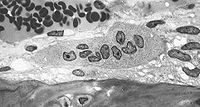
Bone resorption
Encyclopedia

Osteoclast
An osteoclast is a type of bone cell that removes bone tissue by removing its mineralized matrix and breaking up the organic bone . This process is known as bone resorption. Osteoclasts were discovered by Kolliker in 1873...
s break down bone
Bone
Bones are rigid organs that constitute part of the endoskeleton of vertebrates. They support, and protect the various organs of the body, produce red and white blood cells and store minerals. Bone tissue is a type of dense connective tissue...
and release the mineral
Mineral
A mineral is a naturally occurring solid chemical substance formed through biogeochemical processes, having characteristic chemical composition, highly ordered atomic structure, and specific physical properties. By comparison, a rock is an aggregate of minerals and/or mineraloids and does not...
s, resulting in a transfer of calcium
Calcium
Calcium is the chemical element with the symbol Ca and atomic number 20. It has an atomic mass of 40.078 amu. Calcium is a soft gray alkaline earth metal, and is the fifth-most-abundant element by mass in the Earth's crust...
from bone fluid to the blood.
The osteoclasts are multi-nucleated cells that contain numerous mitochondria and lysosome
Lysosome
thumb|350px|Schematic of typical animal cell, showing subcellular components. [[Organelle]]s: [[nucleoli]] [[cell nucleus|nucleus]] [[ribosomes]] [[vesicle |vesicle]] rough [[endoplasmic reticulum]]...
s. These are the cells responsible for the resorption of bone. Osteoclasts are generally present on the outer layer of bone, just beneath the periosteum
Periosteum
Periosteum is a membrane that lines the outer surface of all bones, except at the joints of long bones. Endosteum lines the inner surface of all bones....
. Attachment of the osteoclast to the osteon
Osteon
The osteon, or Haversian system, is the fundamental functional unit of much compact bone. Osteons, roughly cylindrical structures that are typically several millimeters long and around 0.2mm in diameter, are present in many of the bones of most mammals, birds, reptiles, and amphibians.Each osteon...
begins the process. The osteoclast then induces an infolding of its cell membrane and secretes collagenase and other enzymes important in the resorption process. High levels of calcium, magnesium
Magnesium
Magnesium is a chemical element with the symbol Mg, atomic number 12, and common oxidation number +2. It is an alkaline earth metal and the eighth most abundant element in the Earth's crust and ninth in the known universe as a whole...
, phosphate
Phosphate
A phosphate, an inorganic chemical, is a salt of phosphoric acid. In organic chemistry, a phosphate, or organophosphate, is an ester of phosphoric acid. Organic phosphates are important in biochemistry and biogeochemistry or ecology. Inorganic phosphates are mined to obtain phosphorus for use in...
and products of collagen
Collagen
Collagen is a group of naturally occurring proteins found in animals, especially in the flesh and connective tissues of mammals. It is the main component of connective tissue, and is the most abundant protein in mammals, making up about 25% to 35% of the whole-body protein content...
will be released into the extracellular fluid as the osteoclasts tunnel into the mineralized bone. Osteoclasts are also prominent in the tissue destruction commonly found in psoriatic arthritis
Psoriatic arthritis
Psoriatic arthritis is a type of inflammatory arthritis that, according to the National Psoriasis Foundation, will develop in up to 30 percent of people who have the chronic skin condition psoriasis...
and other rheumatology related disorders.
Bone resorption can also be the result of disuse and the lack of stimulus for bone maintenance. Astronaut
Astronaut
An astronaut or cosmonaut is a person trained by a human spaceflight program to command, pilot, or serve as a crew member of a spacecraft....
s, for instance will undergo a certain amount of bone resorption due to the lack of gravity, providing the proper stimulus for bone maintenance.
During childhood, bone formation exceeds resorption, but as the aging process occurs, resorption exceeds formation.
Regulation
Bone resorption is highly constructable stimulated or inhibited by signals from other parts of the body, depending on the demand for calcium.Calcium-sensing membrane receptors in the parathyroid gland
Parathyroid gland
The parathyroid glands are small endocrine glands in the neck that produce parathyroid hormone. Humans usually have four parathyroid glands, which are usually located on the rear surface of the thyroid gland, or, in rare cases, within the thyroid gland itself or in the chest...
monitor calcium levels in the extracellular fluid. Low levels of calcium stimulates the release of parathyroid hormone
Parathyroid hormone
Parathyroid hormone , parathormone or parathyrin, is secreted by the chief cells of the parathyroid glands as a polypeptide containing 84 amino acids...
(PTH) from chief cells of the parathyroid gland
Parathyroid gland
The parathyroid glands are small endocrine glands in the neck that produce parathyroid hormone. Humans usually have four parathyroid glands, which are usually located on the rear surface of the thyroid gland, or, in rare cases, within the thyroid gland itself or in the chest...
. In addition to its effects on kidney and intestine, PTH also increases the number and activity of osteoclasts to release calcium from bone, and thus stimulates bone resorption.
High levels of calcium in the blood, on the other hand, leads to decreased PTH release from the parathyroid gland, decreasing the number and activity of osteoclasts, resulting in less bone resorption.

